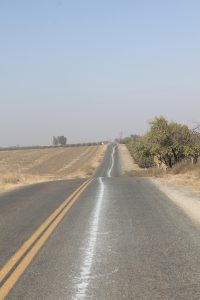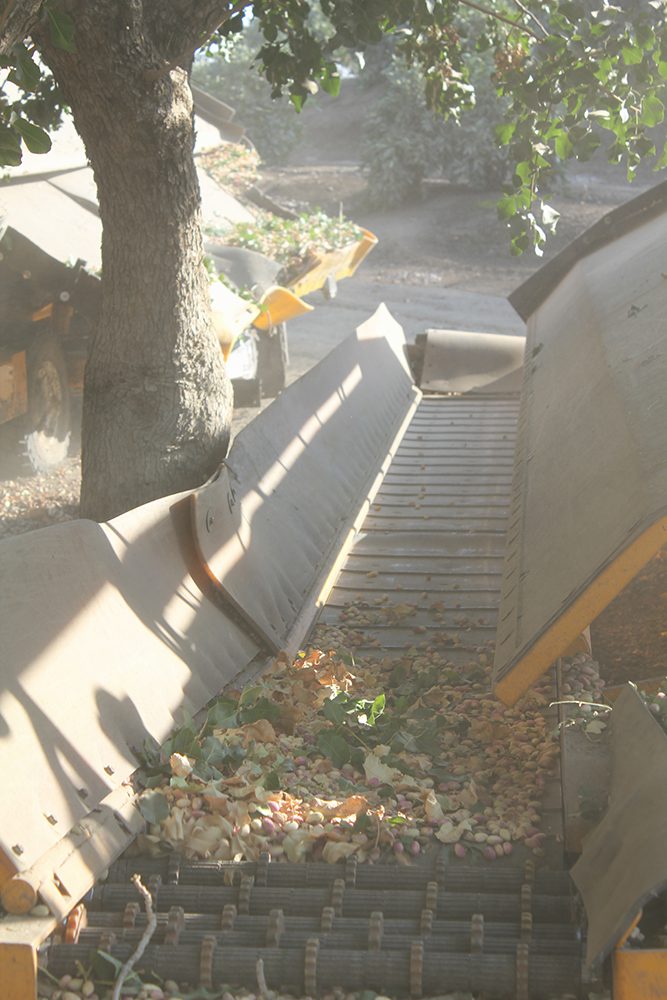
Attention to detail during the growing season helps ensure good yields. Attention to detail after harvest is completed puts an orchard on track to produce a good crop the next year.
Pistachio growers and crop advisors point to postharvest practices that they carry out each year, knowing those essential steps in orchard care will pay off in healthy trees, crop yield and quality and smoother harvests next season.
The UC IPM guidelines note the importance of orchard sanitation and review of all monitoring records from the past growing season to plan postharvest and dormant-season orchard practices. Other items on the top-five list include irrigation to replenish soil moisture, nutrient applications to replace those lost in the harvested crop, application of preemergent herbicides, control of rodents and application of soil amendments.
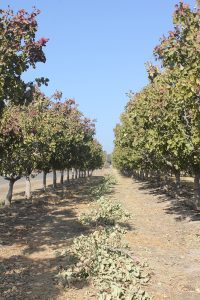
1. Irrigation/Fertigation
Ultra Gro Agronomist Robert Smith emphasizes that irrigation immediately after harvest is critical to tree health. If there is going to be a long period of time between shakes, he said giving trees a shot of water before the second shake is a good idea when it can prevent excessive water stress.
“Shaking is hard on a tree, and you need to replenish the soil moisture as soon as you can after harvest,” Smith said.
Fertilization depends on the tissue analysis that was done in July. Smith said the 4-R strategy (right rate, right time, right place and right source) developed by the almond industry applies to pistachio production, but follow with caution. He said there is no evidence that saving the last 20% of the annual nitrogen budget for postharvest application has any bearing on yields for the next year.
“Twenty percent is too much, it should be more like 20%,” Smith said.
Application should be done postharvest through the end of November, when temperatures and daylight signal trees to begin entering dormancy. Getting the nutrients in the tree builds their carbohydrate load up for next season, Smith said. UC reports on carbohydrate levels in trees show they are at their highest in January and lowest in July. Root growth, leaves and blooms all grow on the stored energy from the fall.
Davis-area pistachio grower Lance Stanley said he uses evapotranspiration rates, a tensiometer and pressure bomb to determine water needs in his block of Kerman pistachios.
“You have to keep moisture in the root zone even during the winter if there is little rain,” Stanley said. It is important to get water to the trees after harvest to prevent stress.
Woodland-area pistachio grower Rick Grewal lists irrigations immediately after harvest as his number-one orchard priority.
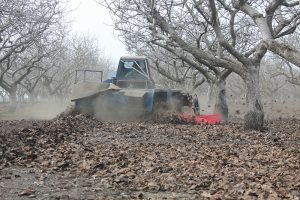
2. Postharvest Weed Control with Preemergent Herbicides
North of the Delta, growers generally receive more rainfall in the winter than growers in the southern San Joaquin Valley, giving weeds a head start in the orchards. Stanley said preemergent herbicide applications and orchard sanitation postharvest go hand-in-hand.
By blowing tree rows clean of leaves, orchard debris and mummy nuts, the preemergent materials make better contact with the soil and are more effective.
“We do a berm blast with the sprayer following right behind,” Stanley said of his weed control efforts.
Grewal noted that he prefers to do his weed control postemergence when he can see there is a problem.
Smith said hairy fleabane is the weed that is hardest to control in many orchards and if it escapes control can be impossible to eradicate. It is resistant to glyphosate, but the Group L29 preemergent Alion and Matrix are effective if applied correctly. He advises applying preemergent herbicides as late in the fall as possible.
“If you applied it early in December last year, you were a genius,” Smith said. In other years, a February application may be more appropriate. He emphasized that the orchard floors be clean of leaves before application.
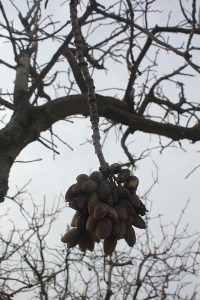
3. Orchard Sanitation
If navel orangeworm has infested your orchard, grade sheets from the processor will reveal the percentage of worm damage in your crop. Smith said he has seen grade sheets with less than 1% damage, then the grade sheets from the second shake top 17%. Mummy shakes after a rain event has added some weight to the remaining nuts on the tree to aid in removal are cost-effective, Smith said. If you and your neighbors practice good orchard sanitation, over time it can reduce the number of insecticide sprays needed to control navel orangeworm.
Stanley includes his pruning crews in orchard sanitation, having them knock bunches of mummy nuts off while pruning trees. He said berms are blown clean of nuts and middles mowed, not disced, to grind the mummies.
“I have been doing this for 12 years with neighboring almonds and walnuts, and this strategy works for me; no navel orangeworm.”
Grewal said he asks the same of his pruning crews but does come back for a shake later to make sure mummies are removed.
4. Rodent Control
“This is a hard one,” Smith acknowledges. Whether it is squirrels, gophers or other vertebrate pests, there must be a multi-pronged approach and it must be sustained. You can’t quit.
It is not so much that nuts are being eaten or trees girdled; Stanley said that chewed drip lines and holes in orchard floor from burrowing rodents are the main headache. In his case, it is gophers that are a year-round control project.
You have to keep at it or they take over the orchard.”
His main tool is the gophinator trap, which while labor intensive has proved to be effective.
Smith targets squirrels with baits and poison, which he said are all labor intensive if the aim is to bring the population under control. The two rodenticides are restricted use and need multiple feedings to be effective. There are only two anti-coagulants available: zinc phosphide and aluminum phosphide which, he said, are 100% effective if used correctly.
5. Soil Amendments
Soil amendments are materials added to orchard soils to improve water retention, infiltration, drainage, aeration and structure to provide a better environment for tree roots.
Soil amendments in pistachios generally consist of compost to improve soil water holding capacity or gypsum to help leach salts from the root zone. Stanley said he applies gypsum and compost once the first berm blast is done and hopefully prior to a rain event to help wash it into the soil.
pplied in the October/November time frame, ideally prior to rain. Before adding amendments, growers need to consider how long the amendment will last in the soil, the carbon to nitrogen ratio and how the amendment will structure in different soil types.
